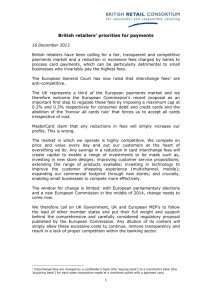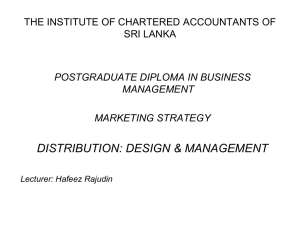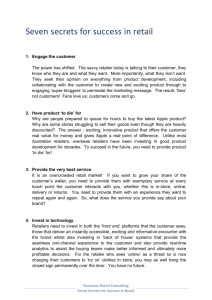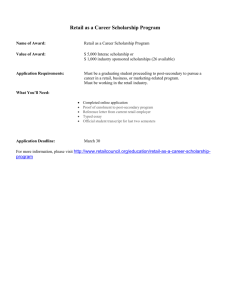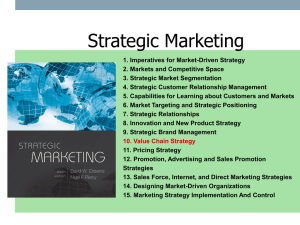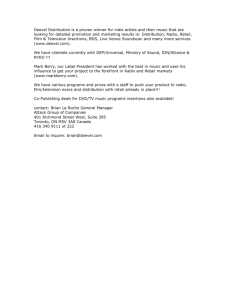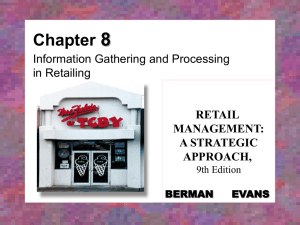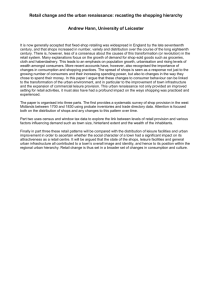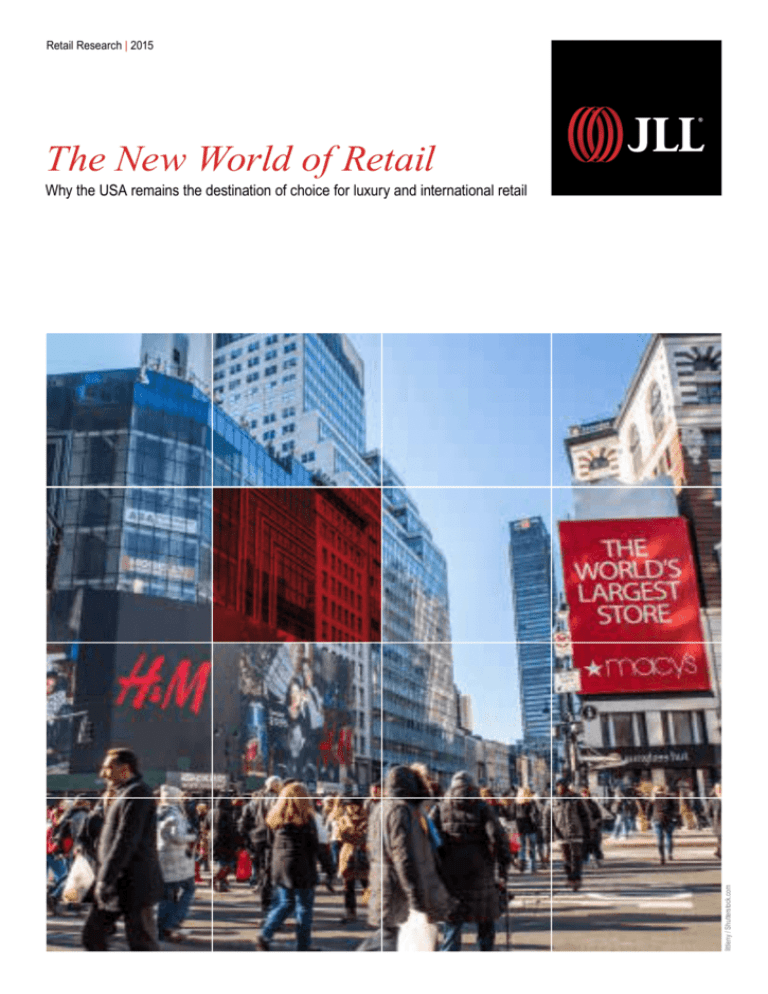
Retail Research | 2015
The New World of Retail
littleny / Shutterstock.com
Why the USA remains the destination of choice for luxury and international retail
2 JLL
Contents
Introduction
5
6
Consumer trends
9
13
Market scoring
Demographics
Retail trends
18
24
City profiles
25
New York
Miami
26
Las Vegas
Los Angeles
27Honolulu
Dallas
28Chicago
Orlando
29Houston
Phoenix
30
San Francisco
Atlanta
31Seattle
Austin
32
San Diego
Boston
33
San Antonio
Washington, DC
34Portland
The New World of Retail
3
4 JLL
Introduction
The United States remains a prime destination for international retailers looking
to expand their borders. It reigns supreme for several reasons, despite the allure
of developing countries such as China and India. First, U.S. population growth
continues to expand rapidly, both through births and immigration. Secondly, the
presence of strong distinct markets, with increased urbanization has created
unique opportunities for expanding retailers. Finally, the generational rise of the
Millennials and the growing demand for novelty in the shopping experience is
fueling new and innovative retail concepts within the United States.
Furthermore, the prevalence of internet usage and the exponential growth of
product and brand research both before and during the shopping process, allows
international retailers to introduce their brand and build awareness, even before
consumers enter their stores.
In this report, we examine the relative presence of over 350 retailers – both
domestic and international – in major markets around the country. We also look
closely at the growth potential, leasing performance and demand strength of each
market and score each against the backdrop of retailer presence. Consistent with
our hypotheses, we found the historically strongest and most well-known markets
(e.g., Manhattan) had not only strong retailer preponderance but a high proportion
of luxury and international retailers. Another interesting finding is the growing
strength and potential of Sun Belt markets in the Southeast, South and West
Coast of the United States, thanks to robust population growth and an increasingly
healthy housing market.
A companion piece to JLL’s Destination Europe 2015 and A Magnet for Retail –
Tracking Retailer Expansion across AP, this is the third in a series of research
reports tracking key developments in retail. Here, we focus on how several
demographic, consumer and retail trends are affecting the attractiveness of the
United States as an international retail destination.
Greg Maloney
President & CEO,
Retail, Americas
Naveen Jaggi
President,
Retail Brokerage,
Americas
Aaron Ahlburn
Director of Research,
Retail
The New World of Retail
5
Demographics
6 JLL
Demographics
Over the last decade or so, the retail landscape in the United States has increasingly been
defined by two major generational cohorts: the Millennials and the Baby Boomers. Historically, the
Boomers have represented the lion’s share of the population and driven many of the cultural trends
observed over the last four decades. However, U.S. culture and consumer behavior is now shifting
thanks to two trends: the aging of the Baby Boomers and the rise of the Millennials.
Aging Baby Boomers create new consumer market
The share of the 65-and-over population grew from 12.4 percent in 1982 to 14.7 percent in
2012. However, contrary to conventional opinion, Early Boomers (those born between 1946 and
1955) have significantly higher net worth than previous generations did in their 50s and 60s. This
has important implications for the tenant mix and merchandising as the needs and demands of
Boomers will change as they get older.
Baby Boomers have essentially reinvented every life stage they have passed through, from young
adulthood to parenting, and now retirement. They continue to look for new experiences and
are remarkably tech-savvy. In fact, 41 percent of customers buying Apple computers are Baby
Boomers; 53 percent of Boomers are on Facebook. Retail categories that are particularly popular
with Boomers include health and wellness, beauty care, and toys and gifts.
Millennials call for innovation and novelty
As big and influential as the Baby Boomer generation is, the Millennial generation is set to be
even larger. The purchasing power of Millennials is estimated to be $170 billion per year. By
2018, that number will soar to $3.4 trillion – higher than any other age group. Millennials are
typically characterized by being digital natives, most at home when using several different forms
of technology simultaneously. They also tend to be impatient, love change and novelty, and are
highly influenced by their peer groups. Store categories Millennials tend to favor include fast
fashion retailers, electronics stores and restaurants.
In response to how these groups – and consumers, in general, shop – investors are looking
either at luxury retailers or deep discounters; mid-priced retailers will continue to see a crunch.
The strong buying power of these cohorts, coupled with their increasing demand (especially the
Millennials) for new experiences and innovation, will help drive growth from international retailers
looking to expand their market reach.
The aging of Boomers pushes up the percentage of the population over age 65
Population over age 65 (millions)
90
80
70
60
50
40
30
20
10
0
69.4
75.2
78.9
Median net worth by generations at the same age (50-69 year-olds)
Median net worth (in 2010 dollars)
Depression Babies (born 1926-1935)
$162,222
75.2
69.4
53.2
34.7
2000
Source: 2010 Census
War Babies (born 1936-1945)
39.4
2010
2020
2030
2040
2050
Early Baby Boomers (born 1946-1955)
$170,604
$241,333
Source: Bloomberg
The New World of Retail
7
The incredible shrinking middle class
With regards to U.S. consumer demand, high or low beats “average.” As aging Boomers and
growing Millennials are shifting the retail landscape, another demographic trend is making waves
in retail: the shrinking middle class. With the decline of discount department stores and mid-range
restaurants, along with the simultaneous growth of fine-dining chains and luxury and boutique
retailers, we are seeing a new pattern emerge, particularly since the last recession.
The share of income earned by the middle 60 percent of the population dipped from 52 percent in
1967 to 46 percent in 2012. Concurrently, the United States has experienced a rise in the share of
income earned by the top 20 percent from 44 percent in 1967 to 51 percent in 2012. The top five
percent of income earners also saw a five percent jump in their income share from 1967 to 2012.
As the distribution of income shifts, the polarization of retail has become – and will continue to
become – more pronounced. Implications are that the demand for luxury products and services
will continue to gain traction in the United States. Additionally, the emphasis on value is nowhere
near subsiding. Luxury retailers and discounters will continue to rule the retail roost in the United
States for the foreseeable future. While middle-of-the-road retailers, as a category, are continually
getting squeezed, there will be individual successes, namely among those who present strong
value propositions, offering unique products, exceptional customer service and an outstanding
shopping experience. High-end international brands and emerging fast fashion retailers can
expect to see good returns from strategic expansion.
Americans heading back to work… and back to shopping
The worst effects of the Great Recession on employment have finally faded. Rising business
confidence is finally bearing fruit in the form of increased hiring. Layoffs are shrinking down to
pre-recession levels. As a result of increased business confidence in the durability of the recovery,
hiring has stepped up to meet increasing demand. As improvements to employment become more
entrenched, income growth will also follow and, correspondingly, so will consumer spending power.
Due to pent-up demand since the recession, consumers are increasingly likely to open up their
pocketbooks in response to higher income.
Share of aggregate income received
Middle 60%
1967
1967
52%
1982
1982
51%
1997
2012
Highest 20%
1997
47%
2012
46%
Top 5%
8 JLL
Source: Census Bureau
1967
17%
1982
17%
1997
22%
2012
22%
44%
45%
49%
51%
The New World of Retail
9
Consumer trends
10 JLL
Consumer trends
For shoppers, omnichannel is the only channel
Much has been made of the growing prevalence of e-commerce as consumers order en masse
from Amazon.com and other internet retailers. The truth is that, while e-commerce is experiencing
double-digit growth, it still represents only a small portion of total sales – 6.4 percent as of the
second quarter of 2014.
The important shift here is that e-commerce sales are replacing traditional catalog sales.
Furthermore, U.S. consumers are using the Internet, not just to purchase, but to conduct
product research before heading into stores, research that was previously done within the stores
themselves.
In this current environment where consumers are becoming increasingly tech-savvy and are
shopping across channels, it is not enough to simply have a store. Retailers have responded by
developing their e-commerce platforms to offer a seamless shopping experience to consumers.
Many of these online retailers are still opening physical stores as well. These physical stores
function as centers for immediate gratification of consumer demands, marketing tools, in-store
pickup of online orders, showrooms and locations for making returns easier.
Many retailers are also using their stores as distribution centers to facilitate same-day delivery and
in so doing, directly competing with online retail. Macy’s, for example, has been shipping online
orders from its stores for over a year, increasing this service to more than half of all its stores over
the last holiday season. Walmart is also now shipping over 10 percent of its online orders through
its local stores (Source Walmart.com).
The bottom line is that physical retail is not going away. Even with the increased sophistication
of e-commerce distribution systems and fast shipping, consumers still crave a physical shopping
experience where they can touch, see and interact with products before buying. This is especially
true in the luxury segment, where products can be widely differentiated. In retail segments where
goods are more commoditized, consumers are buying a greater proportion online.
The New World of Retail
11
Americans ditch long commutes for city living
The increasing urbanization of U.S. consumers has been taking place for years, partially reversing
the previous trend of suburban spread. Consumers are increasingly trading in long commutes
and high-maintenance yards for walkable live-work-shop communities that offer a more seamless
transition from work to home to entertainment and shopping. This is especially true as more
consumers embrace “we-tail” – the provision and consumption of services made possible through
an amalgamated community, such as Uber or Airbnb.
The U.S. urban population increased by 12.1 percent from 2000 to 2010, outpacing the nation’s
overall growth rate of 9.7 percent for the same period. Moreover, approximately 80.7 percent of
the U.S. population lives in urban areas - defined as densely developed residential, commercial
and other nonresidential areas.
This growth in urbanization has important implications for retail: smaller stores, vertical-build,
street-front access, proximity to public transportation and deliveries. Urban cores are a particular
draw to Millennials, 48 percent of those surveyed live in downtown areas or areas just outside
the city (Source: ULI/Lachman Associates Survey). Many Baby Boomers are also attracted by
a walkable urban community. With consumers from both major generational cohorts heading to
cities, retail demand within the urban core is set to explode. Developers are already responding
by building more live-work-play communities; however, the process is a long one. Creative
redevelopment and redeployment of existing urban space is crucial, while additional space is being
developed. Nevertheless, one fact is clear; international retailers who successfully transition to
urban cores are likely to be rewarded with high sales per square foot.
Los Angeles has the greatest population density, surpassing even New York City
Population per square mile
New Orleans, LA
Sacramento, CA
Salt Lake City, UT
San Diego, CA
Miami, FL
Las Vegas, NV
New York, NY-NJ-CT
San Jose, CA
San Francisco-Oakland, CA
Los Angeles, CA
Source: 2010 Census
12 JLL
2,000
4,000
6,000
8,000
Outlets popular with both retailers and consumers
Consumers in the United States continue to be motivated by deep discounts on name brand
products. As a result, outlet center construction has been ramping back up.
Between 2013 and 2016, it is estimated that 21 million square feet of new outlet center space will
be delivered. Additionally, expansions to existing centers will add another 1.9 million square feet.
This bump-up in inventory is in response to a nine percent increase each in outlet center rents and
sales per square foot between 2012 and 2014 (Source: VRN).
Furthermore, many luxury and international retailers are expanding into outlet space, given the
great success of stores within this space. Over the last year, more than 60 new tenants operating
nearly 300 stores have been added to the Value Retail News (VRN) database. Included in this list
are Jimmy Choo, Anne Fontaine and Roberto Cavalli. Other luxury retailers who already have
a strong outlet presence include Saks Fifth Avenue Off 5th, Last Call by Neiman Marcus, Ralph
Lauren and Restoration Hardware.
Outlet store statistics 2014
Total # of outlet chains
368
Total # of outlet stores
12,796 stores
Average outlet chain size
35 stores
Average chain rent/s.f.
$33.72
Average chain sales/s.f.
$397.76
Average store size
4,220 s.f.
Average discount
38%
Source: VRN
The New World of Retail
13
Retail trends
14 JLL
Retail trends
Luxury flourished in major U.S. cities
In the last few years, luxury retailers performed considerably well, experiencing double-digit
increases in sales revenue – due to the fact that their clientele was largely immune to the worst
effects of any economic upheaval. The affluent consumer sector – the top 20 percent of U.S.
consumers that earn over $100,000 in income, annually – make up only one-fifth of the population
but account for more than 40 percent of all consumer spending. Essentially, an affluent consumer,
on average, is spending twice as much as the average consumer. As a result of rising demand,
luxury retailers are opening more and more locations, particularly in urban cores.
A recent study by McKinsey Global Institute revealed that the world’s top 600 cities will account for
85 percent of global growth in 2025. Furthermore, U.S. metropolises like New York and Chicago
are just as critical to luxury retailers’ quest for greater market share as cities in emerging countries.
The eight other U.S. markets in the top ten for luxury retail presence include: Las Vegas, Miami,
San Francisco, Honolulu, Houston, Dallas, Los Angeles and Boston.
With regards to retail type, the greatest portion of luxury and international retailers among the 19
markets tracked in this study are in shopping centers, followed by high street and other retail types,
such as stores within-stores or hotel retail, such as in Las Vegas. Stores-within-stores are very
popular with smaller retailers, allowing them to test markets and brands without the more serious
commitment of a separate store, while also benefitting from the high traffic of the retailers within
which they are located. Also, as previously mentioned, luxury retailers are making use of outlet
centers to increase revenue.
Luxury brand presence by retail property subtype
Other (SIS,
AIR, Hotel)
23%
Outlet
11%
High Street
23%
Shopping
Center
43%
Source: JLL
International brand presence by retail property subtype
Other
23%
Outlet
21%
High Street
22%
Shopping
Center
34%
Source: JLL
The New World of Retail
15
16 JLL
Fast fashion is growing fast
In the United States, a relatively new segment has been growing in popularity – fast fashion. At
one time, the fashion industry worked around a two-season rotation calendar in bringing goods
to market. However, thanks to innovations in technology and logistics, companies like Forever
21, H&M and Zara have disrupted the process – not only changing how often they introduce new
products, but how much they sell, how they profit and what consumers now expect.
The average turnover time, for example, for Zara to design, manufacture and stock store shelves
is approximately one month (Source: NPR). What retailers like Zara have done is completely
transform how fast the fashion industry brings goods to market, even those that aren’t fast fashion.
At the same time, fast fashion retailers work hard to keep clothes affordable for consumers,
thereby, boosting sales volume to hundreds of millions of dollars per year. Furthermore, these
retailers are encroaching into the market share of established teen retailers such as Abercrombie
& Fitch and Aeropostale.
Retailer
Openings in the next 12 months (globally)
H&M
375
Zara
370
Uniqlo
21
Forever 21
15
Source: Retail LeaseTrac, H&M, Uniqlo
Three of the four retailers listed above are international retailers from Sweden, Spain and
Japan. Their success and aggressive growth plans imply that there continues to be significant
opportunities within this segment for international expansion. In fact, the Cowen Group estimates
that U.S. fast fashion sales have the potential to grow at a compound annual growth rate (CAGR)
of 11.0 percent through 2020, given current square footage growth rates. This would result in a
total increase from 2013 to 2020 of 77.0 percent, and a 4.2 percent total share of the U.S. apparel
market.
The New World of Retail
17
18 JLL
Market scoring
The New World of Retail
19
JLL International Retailer Index
In the remainder of this study, we take a look at the relative presence of over 350 retailers – a
mixture of luxury and non-luxury brands – in 19 well-established markets across the United States.
Methodology
A retailer is deemed to be present in a market if it has at least one store, including store-withinstore models, which is a growing trend in the United States, particularly in large department stores.
Stores-within-store are particularly useful for retailers expanding into new markets; they offer a
relatively inexpensive way to test a brand or concept while benefiting from the shopper traffic of
the stores in which they are located. A retailer’s presence within high-end hotels, such as those
on the Las Vegas Strip, has also been taken into account. A total of ten components were used to
score the markets presented in this report. The components used to rank markets are forecasted
population growth, forecasted household income growth, the number of total retailers, luxury
retailers and non-U.S. retailers in a market, rent and vacancy levels, the gross leasable area, the
balance between supply and demand in a market, and a market ‘vitality’ score.
There are U.S. markets that are known for being cosmopolitan with a strong international
presence, such as New York, Los Angeles and Miami. Not surprisingly, these markets came out
on top in our JLL International Retailer Index. Another market with a high international index is
Las Vegas, with many well-known and luxury international brands populating the high-end hotels
located on the Strip. The strong presence of international retailers in these U.S. markets makes
sense since they are all popular tourist destinations, renowned for entertainment and shopping.
When it came to our luxury retail index, in addition to three of these markets (New York, Miami and
Las Vegas), Chicago also scored high, justifiably, given its prominence as a major U.S. market and
the strongest market in the Midwest.
Other high-scoring markets include Dallas, characterized by strong projected population growth,
strong employment and income growth and the ability to draw consumers from outside the market
to shop; Houston, a vital energy-driven market with high income growth and robust leasing
fundamentals; Orlando, with a burgeoning population, young consumers, high tourism and a high
proportion of spending by consumers living outside the market; and, Honolulu, a popular tourism
destination with a very tight leasing environment with minimal vacancies and strong rents.
20 JLL
Top luxury brands present in most U.S. markets
Retailer presence ranking, segmented by luxury and non-luxury
City
Rank
New York
1
Chicago
2
Las Vegas
3
Miami
4
San Francisco
5
Honolulu
6
Houston
7
Dallas
8
Los Angeles
9
Boston
10
Atlanta
11
Orlando
12
San Diego
13
Washington, DC 14
Seattle
15
Phoenix
16
Luxury
Austin
17
Non-luxury
San Antonio
18
Portland
19
0
100
200
300
400
500
600
700
Source: JLL
The New World of Retail
21
International retailer presence
Size represents JLL International Retailer Index score
9
14
Portland
9
Seattle
San Francisco
3
Los Angeles
2
San Diego
13
Las Vegas
15
Phoenix
Austin
San Antonio
5
Source: JLL
22 JLL
Honolulu
12
16
Boston
7
Chicago
1
New York
4
Washington DC
11
6
7
Atlanta
Dallas
8
Houston
Orlando
10
3
Miami
The New World of Retail
23
Retailers from around the world coming to
United States
Retailer country of origin ranking
Turning to the country of origin for international retailers, Italy has been to date, the number one
exporter of retailers to the United States, with the UK and France in the second and third spots.
Italian retailers account for 22.2 percent of international retail stores in this study, while France
and UK account for 22 percent and 18.3 percent, respectively. Of the major international brands,
Swarovski, Bulgari and Rolex are amongst the top brands with the highest presence in the United
States.
European luxury retailers have also expanded extensively in the United States. Italy, not
surprisingly, leads in luxury brands presence, followed by France and the UK. When examining
luxury store saturation across U.S. markets, however, the picture is slightly different with the UK
leading with the total number of luxury stores (37.6 percent) in the 19 markets, followed by Italy
(34.6 percent) and France (15.8 percent), respectively. Clarks and Rolex are the top UK brands,
while Bulgari and Salvatore Ferragamo lead for Italy, and Louis Vuitton and Sephora, for France.
When it comes to retail property subtype, more international retailers have populated shopping
centers (34 percent). Outlet centers, high street and alternative formats, such as stores-in-stores
have approximately the same level of international retail presence – between 21 and 23 percent.
24 JLL
Brand
Rank
Total
Luxury
Non-luxury
Luxury
Non-luxury
1
2
3
Source: JLL
Store count
Rank
Total
1
2
3
Source: JLL
The New World of Retail
25
Retailer concentration, sales per square
foot and market scoring
New York and Miami shine as destination markets
500
450
New York
400
Retail concentration index
350
300
250
Los Angeles
Chicago
200
San
Francisco
150
DC
Miami
Las Vegas
Seattle
Boston
Key
Size of circles
= Sales psf
Min: $84 psf
Max: $1,038 psf
Honolulu
100
Portland
Phoenix Orlando
50
0
Houston
San
Antonio San
Atlanta
Austin
Diego
2.0
3.0
4.0
5.0
6.0
7.0
8.0
-50
Source: ESRI, Moody’s, PPR, CoStar, JLL
26 JLL
Midwest & Southwest
Western markets
Eastern markets
New York
Dallas
Market scoring
9.0
10.0
11.0
12.0
13.0
City profiles
Rank
1.
2.
3.
4.
5.
6.
7.
8.
9.
10.
11.
12.
13.
14.
15.
16.
17.
18.
19.
New York
Miami
Las Vegas
Los Angeles
Honolulu
Dallas
Chicago
Orlando
Houston
Phoenix
San Francisco
Atlanta
Seattle
Austin
San Diego
Boston
San Antonio
Washington, DC
Portland
The New World of Retail
27
New York, New York
RANK 1
New York City is a dominant force in the commerce, finance, media, art, fashion,
research, technology, education, and entertainment arenas and is regarded
by many as the financial and cultural capital of the world. Home to the world’s
busiest shopping corridors, NYC boasts a population greater than 8 million,
more than 10 million daily commuters and an international and domestic visitor
count that exceeds 54.3 million every year. Retailers and investors seeking to
enter or expand in this market benefit from an unparalleled diversity of brands
and consumers with virtually every product and service category represented.
Demand across these categories remains steady throughout NYC where rental
rates are at a historic high and a fairly robust and growing inventory of viable
store opportunities exist. While NYC’s core retail markets like Fifth Avenue,
Times Square, Union Square and SoHo compete for attention, the Downtown
market has emerged as the “hot” market for retailers. With major lifestyle/
destination centers under development at South Street Seaport, Brookfield
Place, World Trade Center and a plan for retail at One Chase Manhattan Plaza,
the interest and activity from a broad spectrum of brands is poised to expand.
The strength and viability of the NYC retail market is further reinforced by the
commitment of top luxury department store brands like Nordstrom, Neiman
Marcus and Saks Fifth Avenue. The trend for retailers to establish and expand
their NYC footprint is expected to continue as positive economic conditions and
population growth continues.
Miami, Florida
RANK 2
Miami has returned to its pre-recession status as an epicenter for commercial
construction. Its growth will outperform the national average long term, thanks
to growing infrastructure, international trade and tourism. As a prime tourism
locale and a target of heavy foreign investment, Miami occupies a unique
position among U.S. markets. The city’s economic recovery is well underway
and with one of the lowest vacancy rates among major U.S. markets, Miami
is largely under-retailed, with only 12 square feet of retail space per person,
compared to the national average of 23 square feet per person. Targeted retail
and multi-use development projects – many of them luxury – are underway. The
ongoing Design District project houses tenants such as Christian Louboutin,
Dior Homme, Louis Vuitton, Longchamp and Prada. Other development projects
include the mixed-use Brickell City Centre and Miami World Center. The Brickell
area, in particular, will be the target of high-end retail expansion going forward.
Additionally, Miami already has prime shopping locales such as Aventura Mall,
Bal Harbour Shops, Village of Merrick Park, Lincoln Road and The Palms at
Town & Country. Demand growth is expected to be concentrated in key areas
such as Brickell, Miami Lakes and South Dade.
28 JLL
Las Vegas, Nevada
RANK 3
With almost as many yearly visitors as New York City, Las Vegas has once
again ‘re-invented’ itself as THE adult playground of the world. As home to
some of the hottest hotels, nightclubs and casinos, Las Vegas has now also
become a vitally important location for luxury, aspirational and mass market
retailers. The Forum Shops at Caesars ranks as one of the top five shopping
centers in terms of sales per square foot in the United States. The newly
opened Crystals project is home to flagship stores for Tom Ford, Tiffany
and dozens more. In addition, one of the most shopped outlet projects are
located just outside the Las Vegas Strip, a 4.2 mile stretch of South Las Vegas
Boulevard. Shopping is now as important to the Las Vegas economy as
gambling, with many visitors spending more money in the stores than they do
in the casinos! Many retailers see Las Vegas as a potential 3-5 store market
with many luxury brands having 2-3 stores just on the Las Vegas Strip plus an
outlet store. Fashion Show Mall, a five-department store regional mall across
from the Wynn hotel is another retail venue of note. Future growth in Las Vegas
will include new tourist destinations and projects such as The Grand Bazaar,
an outdoor retail project at the busiest intersection along the Strip. This project
will be home to SWATCH and Swarovski flagship stores as well as dozens of
additional unique concepts not yet in the market.
Los Angeles, California
RANK 4
Hooray for Hollywood!! Well established as the entertainment capital of the
world, Los Angeles has become much more to retailers than just Beverly Hills
and Rodeo Drive. Home to one of the most productive (in terms of sales per
square foot) shopping centers, The Grove, Los Angeles has over the past
few years seen the emergence of vibrant and exciting new neighborhoods.
Downtown L.A. and the Arts District have emerged as commercial and residential
centers for technology companies and are now seeing retail growth for
restaurants, galleries and fashion. Venice, in particular Abbott Kinney Blvd, has
become an important retail venue sought after by new and established fashion
brands and restaurants from around the world. Fashion tenants on Abbott
Kinney include Rag & Bone, Stag, Civilianaire, Robert Graham, Tom’s, and a
rumored new Nike Running store. Rodeo Drive has undergone a significant
resurgence post the financial crisis and rents are projected to soon exceed four
figures per square foot. Westfield Century City, which is starting a multi-hundred
million dollar re-development, will be the next large scale project to come on
line. Located between Beverly Hills and Santa Monica, Century City will continue
Westfield’s development of iconic retail venues worldwide.
The New World of Retail
29
Honolulu, Hawaii
RANK 5
Situated on the Island of Oahu, Honolulu is the largest city in Hawaii and is the
state’s center of business, retail and government. Waikiki, the primary tourist
destination for hotels and shopping, is consistently ranked one of the greatest
beaches anywhere in the world. The retail market in Waikiki is centered on
Kalakaua Avenue, which is home to flagships for many of the world’s leading
luxury brands. Also on Kalakaua are two well-known destinations, the
International Market Place (IMP) and Royal Hawaiian Center. Taubman, the
current owner of IMP, recently began redeveloping the site into a three-story
outdoor shopping venue which will be the home to the first Saks Fifth Avenue
department store in Hawaii. Also in Honolulu is the two million-square-foot
Ala Moana Shopping Center, the largest open-air shopping center in the
world and one of the top 10 malls in the United States. Currently undergoing
a 650,000-square-foot expansion, Ala Moana will debut the state’s first
Bloomingdale’s department store. Hawaii has been known to be under-retailed
per capita compared to continental U.S. standards, and many chains, such as
Victoria’s Secret, Costco, Wal-Mart, Home Depot, The Cheesecake Factory and
Safeway count their Hawaiian stores among the highest producing. Honolulu
is currently undergoing a construction boom with more than 1,500 units under
construction in urban Honolulu and another thousand plus being planned
as well as thousands of other housing units planned in suburban Honolulu.
Additionally, construction is well underway on the $5.2 billion light rail system
that will connect Kapolei to Honolulu, with the first leg slated to open in 2017.
Dallas-Fort Worth, Texas
RANK 6
With a population base of more than 6.8 million, Dallas-Fort Worth (DFW) is the
fourth largest metropolitan area in the United States. The most significant factor
shaping the market is its diversified economic growth. Since 2010, DFW added
almost 400,000 people to its population base – putting its growth at the top of
all U.S. markets. These strong fundamentals are expected to continue as job
gains from corporate expansions and relocations attract new residents to the
region. Ample land has also allowed DFW to historically develop in a suburban
style. Despite this, it has a dense urban core with a thriving arts district. While
most retail here serves the daytime workforce, an important anchor is Neiman
Marcus’ original flagship department store. The neighboring Uptown area has
also emerged as a successful “live, work, shop, and play” area with standard and
upscale restaurants and apparel and furnishings retailers. DFW’s suburbs are
growing and quite varied in demographic make-up and retail offerings. Because
of the suburban development pattern, grocery-anchored centers, power centers,
and traditional malls are common. Due to the region’s high concentration of
affluent households, several specialty shopping areas also exist that rival the
best retail nationally.
30 JLL
Chicago, Illinois
RANK 7
The capital of the Midwestern U.S, and the third most populous city in the U.S.,
Chicago is an important business hub as well as a vibrant tourist destination
for international and domestic visitors alike, with 48 million visitors annually.
Situated on the shores of Lake Michigan, nicknames include the “Windy City”
and “Second City”. The city is an international hub for finance, commerce,
industry, technology, telecommunications, and transportation, ranking seventh in
the world in the 2014 Global Cities Index. Chicago’s most famous retail area is
an eight block stretch along North Michigan Avenue known as the “Magnificent
Mile” which is lined with fine luxury, premium and mass market retailers. The
city has many neighborhoods such as Lakeview, Wicker Park, Lincoln Park and
Bucktown, that are filled with local boutiques and premium food and beverage
operators. The suburbs are dominated by a host of great, indoor, shopping
malls (e.g., Woodfield Mall, Oak Brook Mall and Old Orchard) even if major
new product is only slowly being developed. One notable exception is the
high-end outlet mall, Fashion Outlets of Chicago, which opened in Rosemont,
a near suburb of Chicago, in August 2013, and is the first new indoor mall built
in the Chicago area in two decades. The center has become very popular and
is reporting successful sales, and solidifies that retail is alive and well in the
Chicagoland area.
Orlando, Florida
RANK 8
Over 55 million tourists, including nearly four million international visitors, flock
to “The Theme Park Capital of the World” each year, making Orlando the most
visited American city in the United States. Home to Disney World, Universal
Studios Park and many other thematic sites, the market has virtually no relevant
high-street retail. Instead, several retail developments are directly integrated
with the theme parks including Downtown Disney, the new Disney Springs,
Universal City Walk, and the resurgent International Drive, where the Orlando
Eye, a 450’ Ferris Wheel, is near completion. These developments dominate
the retail market alongside two major regional malls: Florida Mall and the
more upscale Mall at Millenia. Additionally, two outlet centers in Orlando have
become a big part of this vacation destination. The Mall at Millenia and Premium
Outlets Vineland were the 4th and 6th ranked malls for sales per square foot in
the United States in 2013. Outside of the “tourist corridor” as it’s known, there
are several neighborhoods driving retail within Orlando including the upscale
Winter Park and Windermere communities, East Orlando, which is home to
the University of Central Florida (UCF), and the booming mixed-use planned
community of Lake Nona. Much of the rest of Orlando retail is driven by the
grocery-anchored shopping center market. Publix Super Markets, headquartered
in nearby Lakeland, operates 756 stores throughout the state of Florida, many of
which anchor the small-shop space in the Orlando market.
The New World of Retail
31
Houston, Texas
RANK 9
Houston’s current population of 6.4 million residents has experienced a 9%
growth over the past five years thanks in large part to the energy markets
growth within the city. As oil and gas companies expand their footprints
within Houston, they are looking to hire top level employees. This white-collar
expansion has given Houston an influx of households with incomes greater than
$100,000. In turn, this increase in disposable income has spurred a growth
within the mid to high-end/luxury retail market to the tune of nearly 1.6 million
square feet – projected to arrive in 2014. Houston’s major retail markets like
Uptown Park, City Centre, and the Woodlands have all benefited from a shift
to a focus on “live, work, play, shop” within the Houston office and residential
markets. In addition, those core areas are benefiting from the expansion of key
luxury retailers looking to capitalize on Houston’s robust economy. Nowhere is
this more evident than in the Galleria district of the city where retailers Cartier,
Dior, Hermes and Tom Ford have all announced new stores openings at Oliver
McMillan’s River Oaks District project, and Saks Fifth Avenue has announced
a move into a 198,000-square-foot location, nearly doubling their Galleria
footprint.
Phoenix, Arizona
RANK 10
The Valley of the Sun is the 12th largest metropolitan area in the United States
with a population of 4.4 million. Historically known to be driven by its real estate,
Phoenix has recently emerged with a much more diverse economy. Trade,
transportation, and retail accounts for 20 percent of Phoenix’s employment,
while professional and business services, education and health services
round out Phoenix’s top three largest drivers. Expected to outpace national
growth, Phoenix’s population and employment gains will continue to open
new opportunities in the market. The Valley’s retail closely reflects its diverse
economy ranging from Scottsdale Fashion Square, the largest shopping mall in
the Southwest, to growing boutiques in the heart of local communities such as
Downtown Chandler. The proposed expansion of Phoenix’s successful light rail
system will help connect more than 14.5 million annual riders beyond Downtown
Phoenix, the Sky Harbor International Airport, and Tempe’s Arizona State
University to more communities and retailers across the city. Retail vacancy has
been trending downward since the recession. The recovery has been largely
driven by big box retailers with Conn’s, At-Home, WinCo Foods, Sprouts, Living
Spaces, Shoppers Supply and Cal-Ranch all adding new stores in the last 18
months. Consistent employment gains coupled with a slow, but steady increase
to income will continue to propel the city forward.
32 JLL
San Francisco, California
RANK 11
Considered one of the best places to live in the United States, San Francisco
is a combination of cool and traditional. It is a city with more than 20 distinct
neighborhoods each with its own vibe and culture. The most important
shopping areas include: Union Square, The Mission, Hayes Valley, The
Fillmore, The Marina District, North Beach, The Financial District and Jackson
Square. Recently, Apple has started construction on a new Union Square
flagship, taking over the former Levi’s store. Topshop has opened on Powell
Street (where the cable cars run), joining Forever 21, Uniqlo and H&M. Along
Market Street, we find flagship stores for Puma, Diesel, American Eagle, The
Gap and Old Navy. San Francisco Center, located at the intersection of Powell
and Market Streets, features a Nordstrom department store on the upper floors
of this urban, regional shopping center that is also connected to BART (Bay
Area Rapid Transit). San Francisco is a key market for international retailers
early in their expansion. The city has a formula retail law which currently states
that if a retailer has more than 11 (or 12 in some markets) stores in the U.S. you
are not able to open in the market. While not the only U.S. city to have enacted
(and enforced) such legislation, San Francisco is decidedly more proactive in
this regard.
Atlanta, Georgia
RANK 12
Fast growing Metro Atlanta, known as the “Capital of the Southeast,” is home
to 5.5 million people, a population which has doubled in less than 25 years.
This rapid growth has put Atlanta on the world stage, ranking 15th among
world cities and sixth in the United States for gross domestic product. Atlanta’s
diverse economy includes logistics, professional and business services, media
operations, and information technology as well as top research universities such
as Emory University and the Georgia Institute of Technology. The sprawling
metro region, served by the busiest airport in the country, covers over 8,000
square miles, creating the space for abundant retail. Atlanta is rich in all types
of retail and home to one of the South’s largest malls, the Mall of Georgia. High
street retail is minimal here with the iconic shopping destinations being the twin
malls in Buckhead: Lenox Square and Phipps Plaza. Buckhead is the crown
jewel of Atlanta, a neighborhood filled with gracious homes, elegant hotels, fine
restaurants and luxury retailer. New on the scene is Olivier McMillan’s Buckhead
Atlanta, a luxury mixed-use development, long in the works, which opened
September 2014.
The New World of Retail
33
Seattle, Washington
RANK 13
Employment in Seattle has outpaced the national average since 2010. The
presence of Microsoft, Google, and especially Amazon has made Seattle an
international center of technology. With Amazon continuously adding jobs,
the local workforce could double to more than 40,000 in the next five years.
Above-average population growth and employment growth in high-paying tech
industries is boosting retail sales and, consequently, demand. The recent
residential construction boom, concentrated in the market’s urban core, should
boost retail sales downtown. In fact, buying power (population multiplied by
income) is expected to rise at least 20 percent by 2018 – a factor that could
support more than 1.5 million square feet of new retail. The fact that scheduled
deliveries are only half that figure reveal that Seattle is relatively under-retailed.
The glut of well-paid, younger residents in the market is resulting in an increase
in demand for groceries and luxury goods. Construction has started to come
back, but this process has been a gradual one. The recently-built Grand Ridge
Plaza at the Issaquah Highlands has started opening stores. Rents have turned
the corner and are heading up, but are still competitively low. This won’t be the
case for long, especially in the CBD, thanks to the difference between the level
of retail that current demand can support and what is actually on track to be
delivered.
Austin, Texas
RANK 14
The state capital of Texas, Austin is the 11th largest city in the United States, and
the fourth largest city in the Texas. The population mix is diverse and includes
government employees, university faculty, foreign and domestic college students,
musicians, and technology and blue collar workers. Austin has high-tech roots,
being the birthplace of Dell computers and is now home to several corporate
technology development centers. Other notable retailers such as Whole Foods
were also born here. A vibrant music scene earns Austin the nickname “The
Live Music Capital of the World”. Austin’s retail market is thriving and retailers
and investors see a lot to like, with employment levels beating previous cycle
highs and some of the strongest population growth in the country. n terms of
variety, Austin’s retail runs the gamut from the eclectic collection of boutiques in
the Second Street District to the 700,000 square feet of shops at Simon Property
Group’s megamall, The Domain. Retail demand has grown steadily and Austin’s
economy is arguably the strongest in the country. The big spender population
category (ages 35–54) will expand by a phenomenal 10% over the National Index
forecast. The recent demand has been answered mostly by smaller retailers with
the exception of a few large leases in 2013 by Gander Mountain and LA Fitness,
leaving the door open for national players.
34 JLL
San Diego, California
RANK 15
San Diego is the 17th largest metropolitan area in the United States with a
population of 3.2 million. The San Diego region enjoys a diverse economy,
with defense, tourism, biotechnology and communications being the largest
industries. San Diego’s retail closely reflects its diverse economy ranging from
Fashion Valley Mall in Central San Diego, the largest and most successful mall
in the region on a sales per square foot basis, to boutiques in local communities
from La Jolla, through Del Mar and Solana Beach, to the up and coming village
of Carlsbad in San Diego’s storied North County. Grocery-anchored centers
and power centers are also common due to the suburban nature of development
in the region. Recent activity has been driven by restaurants, grocery stores,
health clubs and specialty retailers that don’t want to locate in one of the
region’s eight regional malls, opting for open-air lifestyle centers or street retail
in San Diego County’s quaint coastal communities. There are several high
profile developments in the works including Kilroy’s One Paseo in Carmel Valley,
Coast Income Property’s Pacific Highlands Ranch in Carmel Valley and three
Sudberry projects; Civita in Mission Valley, Watermark in Scripps Ranch and
Millenia in Otay Ranch/Chula Vista.
Boston, Massachusetts
RANK 16
Boston is the largest city in New England and one of the oldest cities in the
United States. The city is known for its championship teams, local breweries,
fresh seafood and Beantown pride. There are over 60 major colleges and
universities in Boston, including Harvard and M.I.T. The 700,000 residents and
19 million annual visitors help to make Boston a vibrant and growing city. The
Boston area is a hub of the footwear industry and home to the headquarters of
top brands like Converse, New Balance, Reebok, Puma, Sperry Top-Sider and
Saucony. Whether you are looking for footwear or other goods, Boston has
a variety of shopping options from big malls to tucked-away boutiques. The
most important shopping areas include Newbury Street, The Prudential Center,
Copley Place, Downtown Crossing, Faneuil Hall Marketplace, Harvard Square
and the Cambridgeside Galleria. More than two dozen high-end retailers have
opened stores in Boston in the last few years while established luxury retailers
like Chanel and Hermès are expanding. Shoppers can also find everyday basics
at one of the six locations that Uniqlo is opening in the Boston area by Spring
2015. City demographics are changing as one-fourth of Boston residents are
now foreign born and most of the new housing developments are high-end
residences. As a wealthy international presence rapidly increases in Boston, the
retail market will continue to develop and grow as well.
The New World of Retail
35
San Antonio, Texas
RANK 17
Serving as the seat of Bexar County, San Antonio is the 7th largest city in the
United States and the second most populous in Texas. Often referred to as the
“Military City”, the military’s economic impact is strong, making up one-fifth of
the metro’s total employment. San Antonio has a diversified economy focused
primarily within the military, healthcare, civil service, oil and gas, and tourism
sectors. The city is home to several Fortune 500 companies and other large
headquarters including; Valero Energy Corp., Tesoro Corp., USAA, NuStar
Energy and Clear Channel Communications. San Antonio’s proximity to the
Eagle Ford Shale is increasing the metro’s prominence in energy and accounts
for growth of more than 25% in the energy sector. San Antonio’s retail market
has had a strong recovery from the pre-recession vacancies and retail sales
continue to outpace the national rate. Retail demand has been strong from
midsized tenants such as Hobby Lobby, Dick’s Sporting Goods & Gander
Mountain. The metro’s employment growth is anticipated to be among the
highest in the United States, and population growth is expected to grow faster
which will bode well for retail sales growth. The majority of projects are fully
leased to national retailers, however as recovery grows and homebuilding picks
up, developers will be breaking ground on a number of projects to keep up with
demand.
Washington, DC
RANK 18
A city of great significance both here and internationally is seeing a resurgence
of its in-town retail presence. Traditionally, Washington, DC is a city where
many of the workers lived in the suburbs, resulting in a strong regional shopping
center presence in Maryland and Virginia, the adjoining states. Within the city,
retail as centered in two major neighborhoods, DuPont Circle and Georgetown.
Georgetown has been the focal point of nightlife and retailing with many of
the aspirational and mass market brands opening here – Apple, Restoration
Hardware, Ben Sherman, AllSaints, Barbour and many more. The luxury
brands have typically migrated to the area in and around Dupont Circle. Now
Washington, DC is seeing renewed vigor with major construction of offices,
mixed-use, luxury housing and new retail corridors. The on-going and soon
to open City Center project with its luxury retail mix including Burberry, Louis
Vuitton, Longchamps, Loro Piana and a number of first-to-market restaurants
is a signal that things are changing. The emergence of the 14th Street corridor
and its hip, cool vibe of new restaurants and retailers, including the first Shinola
store, indicate that Washington, DC is once again becoming a city to live in and
call home.
36 JLL
Portland, Oregon
RANK 19
Portland’s above-average population growth and outstanding job growth have
worked in its favor, making it an attractive market for both corporate and retail
expansion. The market’s reputation as a tech-center has not only boosted
employment, but has also increased the number of well-educated, highly-paid
residents in the area. Tourism has also been a boon to the local economy;
in the last year, visitors spent four percent more money on hotels, food,
entertainment and shopping than in the prior year. Thanks to increasing retail
sales, retailers’ confidence is increasing, resulting in growing expansion plans
in the market. Cumulative growth in the big-spender cohort (ages 35-54) is
expected to near 3.5 percent by 2018, a factor almost certain to push up retail
demand even more. Portland’s CBD is especially popular with retailers such as
H&M, Tory Burch, Apple and Microsoft opening new stores in recent months.
Construction remains minimal, which could be a challenge for expanding
retailers, since vacancy is already at pre-recession levels. Rents fell 15 percent
during the downturn but, thanks to limited supply, pricing power should remain in
the hands of landlords for the next few years.
The New World of Retail
37
38 JLL
Conclusion
As we look ahead, we see the U.S. as being well into recovery from the deepest and
longest recession since the mid-20th century. Retail sales have rebounded and most
states are either in recovery or in the case of Texas and Massachusetts, which are
home to five of the markets ranked in the report, in expansion mode (Source: Moody’s
Economy.com). As the millennial generation matures, they will continue to change the
face of the retail industry, influencing the entire shopping experience from technology
and the mix of channels, to the physical store and delivery methods.
Despite the tremendous economic and cultural changes over the decades, the U.S.
economy has shown enormous resilience to weather cycles of boom and bust. Strong
in technology innovation, and with a population that is consumer-minded and trendsetting, the U.S. as the “new world” of retail, will surely continue to be the destination of
choice for international retailers now and in the future.
The New World of Retail
39
JLL offices
Americas Retail
3344 Peachtree Rd NE
Suite 1100
Atlanta, GA 30305
tel +1 404 995 2100
fax +1 404 995 2184
www.jllretail.com
Americas Headquarters
200 East Randolph Drive
Chicago IL 60601
tel +1 312 782 5800
fax +1 312 782 4339
www.us.jll.com
www.jllretail.com
Jones Lang LaSalle
© 2014 Jones Lang LaSalle IP, Inc. All rights reserved. All information contained herein is from sources deemed reliable; however, no representation or warranty is made to the accuracy thereof.

